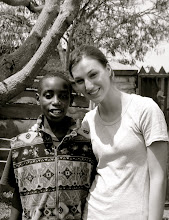Last Tuesday, Jean Claude took us to the Murambi Genocide Memorial. The Memorial was once a technical school where tens of thousands of Tutsis were sent for protection in April of 1994. They were told that French soldiers would protect them there, but for days they lived without electricity and water and only had access to stones to defend themselves in the case of an attack. On April 21, French forces left the compound and Hutu militia attacked, killing 50,000 Tutsis in one of the most horrifying massacres of the Rwandan genocide. The bodies were dumped into mass graves, and left there until the memorial was created.
When we arrived in the late afternoon, there was a thick layer of fog covering the mountains surrounding the compound. Because Murambi is situated on a large hill, all the surrounding villages were visible in the distance, appearing shockingly green and lush in the fading light. I found myself feeling guilty for thinking the view was beautiful in contrast to the hideous brutalities that had taken place within the walls of the site. A solitary purple banner marked the memorial, commemorating the horrific deaths of the thousands of innocent Rwandans that had been murdered on that fateful day. Like many African cultures, color symbolism is incredibly important for signifying happiness and sorrow in Rwanda, and it was interesting to hear that purple, not black, is a symbol of death.
An older woman greeted us as we approached the main building. She was very kind to us, but her expression was stern and her face was weathered by age. She didn’t speak English, so Jean Claude served as our translator as she took us around to the different buildings in the compound. First, we approached a long and narrow building with about 10 identical doors. She opened the first one and I was immediately taken aback by an excruciating smell that seemed to fill my entire body within seconds of entering the room. As my nose adjusted to the shock, my eyes finally began to focus on the scene around me. Dozens of skeletons were scattered across tables. There were many large skeletons, but I was shocked to the skeletons of babies and children as well, some still wrapped in their parent’s arms. Many were missing arms and legs. Others had dozens of bullet wounds on their bodies. Some skeletons didn’t have heads.
Our guide told us that her husband had been killed at Murambi, and after the genocide ended, she decided to stay and work at the memorial. I thought about how difficult it must have been for her to live in the place where she had lost the people she loved the most. As we walked from room to room, everything seemed harder to bear- the smell, the bodies, and the darkness. The number of rooms seemed to be infinite and I realized after we had viewed our last room that we had only seen a tiny portion of the thousands of people who had lost their lives.
We were lead to another part of the compound where the mass burials were located. A large wooden sign marked where French soldiers used to play volleyball right next to where the bodies were thrown into mass graves. We were also lead through a room where the clothes of genocide victims were on display. As we started to walk back towards the main building, I tried to imagine what Murambi would have looked like in April of 1994. I attempted to put the number of deaths into context, but I couldn’t even begin to imagine what 50,000 people looked like, but alone put together an image of that many people struggling to survive.
(Our group posted a video of Murambi on youtube. Check it out at http://www.youtube.com/watch?v=fq7TOXrc3Mw)

Your account and the video are moving testimonies to the horrible tragedy which took place in Rwanda. Truly, this is the Auschwitz of your generation.
ReplyDeleteI've read a quote from former President Clinton who said, when briefly stopping in Kigali in 1994, "Never again." Sadly, that echoes the sentiments expressed after 6 million perished in the Holocaust while the world stood by. Seems as if words alone are just never enough.